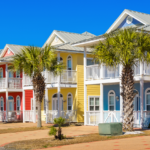In today’s real estate world—at least here in America—condominiums and townhouses are two of the most popular housing choices for many singles, couples, families just starting out, and empty-nesting retirees.
Yet, even with their similarities in structural design and community living aspects, there are significant differences when it comes to property insurance coverage.
Understanding the differences between condo insurance and townhouse insurance is key for homeowners to make sure they have the right coverage for their specific type of home.
Let’s explore the details of each — condo insurance and townhouse insurance — to understand them better.
What Is condo insurance?
Condominium insurance, often referred to by professionals as HO-6 insurance protection, is designed to cover the interior of a condo unit and personal belongings kept within the unit. Some people call condo insurance “walls-in” insurance, meaning it covers the condo interior and everything inside, including personal possessions and things attached to the walls like utilities and fixtures.
Since condominiums typically involve shared spaces and communal structures — like lobbies, elevators, and hallways — the insurance coverage for individual unit owners differs from that found in a traditional homeowners’ insurance policy.
Here are some key features of condo insurance:
- Dwelling coverage: Your condo insurance is designed to return your condo to its original state after a covered event. Whether it’s damage from a fire, vandalism, or certain water-related incidents, this coverage steps in to cover the costs of repairs or rebuilding. It includes everything from walls, ceilings, and floors to plumbing, electrical systems, built-in appliances, and fixtures.
- Personal Property Coverage: Condo insurance primarily focuses on protecting the interior space of the unit, including fixtures, appliances, and personal belongings. This coverage extends to unforeseen risks and damages within individual units caused by things like fire, theft, vandalism, and some natural disasters. It does not cover things stored in hallways or common area storage units.
- Personal Liability Protection: Condo insurance includes liability coverage, which protects the condo owner against lawsuits that stem from injuries sustained by anyone within the unit caused by the policyholder’s negligence. This coverage can be extended to cover the legal costs of personal injury lawsuits stemming from libel or slander claims against you.
- Medical Payments: This coverage handles medical expenses for guests or roommates who get injured in your condo, regardless of who’s responsible. It’s intended to promptly address minor injuries without the need for legal disputes.
- Loss Assessment Coverage: If a common area in the condo is damaged—let’s say a roof repair is needed or the laundry room needs maintenance due to a water main break—the homeowners association may perform a “loss assessment” on every owner in the condo complex, requiring them to pay a shared portion to repair the damage. This coverage is important in condo living because shared spaces and amenities require everyone to pitch in for maintenance and repairs.
- Loss of Use: If your condo becomes uninhabitable due to covered damages, condo insurance typically provides coverage for additional living expenses, such as hotel stays, ordering food from restaurants, etc. This aspect of condo insurance — which is sometimes included in a basic policy and sometimes treated as an add-on — ensures that condo owners can maintain a standard of living if displaced due to a covered event.
Often, your mortgage lender or condo association will require you to buy a policy. Even if it’s not mandatory, having coverage is always a good idea for property and liability protection. For a deeper dive into condo insurance, read “Condo insurance: What’s covered and what’s not?”
Here are the named perils typically covered by a condo insurance policy:
- Damage from aircraft
- Damage from automobiles and moving vehicles
- Explosions
- Falling objects
- Fire and lightning
- Freezing pipes
- Hail and windstorms
- Riots
- Smoke
- Sudden and accidental damage from artificial electric currents
- Theft
- Vandalism
- Volcanic eruptions
- Water damage from plumbing or HVAC overflow
- Water heater damage
- Weight from snow, ice, or sleet
What is townhouse insurance?
Unlike condos, townhouses are standalone structures that share walls with neighboring units, offering a blend of privacy and community living. Also, unlike condos, townhouses do not have a specific type of insurance.
If you own a townhouse, you’ll need a homeowners insurance policy — usually referred to as an HO-3 policy — just like someone with a detached house would get. The good news is that your premiums might be lower since townhouses are usually smaller than single-family homes.
Here’s what you need to know about insuring your townhouse:
- Structure Coverage: Townhouse insurance provides comprehensive coverage for both the interior and exterior of the unit, safeguarding everything from the walls and roof to floors and even attached structures like garages or decks. It even covers the land beneath your home. This inclusive coverage extends to damages caused by a variety of covered perils, including fire, windstorms, vandalism, and theft.
- Personal Property Protection: Like condo insurance, townhouse insurance prioritizes the protection of personal belongings within the unit. This means coverage for a wide range of items, including furniture, electronics, clothing, and some valuables. This can help homeowners recover financially if their property is lost or damaged.
- Liability Coverage: Townhouse insurance gives homeowners strong liability protection, covering them if they’re legally responsible for injuries or property damage. This coverage is important for protecting against unexpected accidents or incidents on the property.
- Loss of Use Coverage: If a townhouse becomes unlivable because of covered damages, loss of use coverage kicks in to ease the financial strain of finding a temporary place to stay. This helps homeowners manage extra living costs while repairs to the home are taking place.
Here are the named perils typically covered by a HO-3 policy for insuring a townhouse:
- Accidental overflow or discharge of water or steam
- Damage from aircraft or cars
- Explosions
- Falling objects
- Fire and lightning
- Freezing
- Hail and windstorms
- Riots
- Smoke
- Sudden and accidental damage from artificial electric currents
- Sudden and accidental tearing apart, burning, or cracking from a built-in appliance like a water heater or an HVAC system
- Theft
- Vandalism
- Volcanic eruption
- Weight from snow, ice, or sleet
Key differences between condo insurance and townhouse insurance
While both condo insurance and townhouse insurance offer similar types of coverage, the primary distinction lies in the extent of structural coverage provided.
COVERAGE
For condo insurance, an HO-6 policy includes coverage for the interior walls, carpets, countertops, plumbing, cabinets, and personal property/contents, along with liability protection. Meanwhile, an HO-3 policy, the one generally used to insure townhouses, covers all those items as well as the roof, frame, foundation, exterior walls, floor, fixtures, property, and outbuildings.
In short, condo insurance typically covers only the interior of the unit, whereas townhouse insurance extends coverage to both the interior and exterior.
COSTS
Typically, a two-bedroom townhouse might have slightly higher insurance costs compared to a two-bedroom condo with similar features. This is often because townhouses are standalone units, meaning they usually have more exterior surfaces to insure, including the roof, siding, and possibly a yard.
Additionally, townhouses may have different structural features or amenities that could affect insurance rates. However, the actual cost difference can vary depending on various factors such as location, construction materials, security measures, and individual insurance policies.
COMMON AREAS
Additionally, condominiums and townhouses often differ in their handling of common areas and shared structures. Condo associations often have master insurance policies that cover common areas, necessitating loss assessment coverage for individual unit owners.
On the other hand, townhouse communities may have homeowners’ associations (HOAs) responsible for maintaining exterior structures, which could reduce the necessity for loss assessment coverage for individual owners. That’s not to say that condo buildings don’t have HOAs. They often do; it all depends on your specific situation.
So, what do townhouse insurance and condo insurance have in common?
While this blog discusses the differences between condo and townhouse insurance, it’s good to know that they have some things in common, like what they don’t cover.
- Certain dog breeds
- Earth movements
- Flooding
- Government action
- Home-based business operations
- Intentional damage
- Local building ordinances or laws
- Mold or wet rot
- Nuclear hazards
- Pest infestations
- Power surges caused by your utility company
- Wear and tear or neglect
- War
We’re here To help!
In essence, the choice between condo insurance and townhouse insurance depends on the specific characteristics of the dwelling and the associated insurance needs. Consulting with an insurance agent knowledgeable in these types of policies can help homeowners make informed decisions and ensure they have adequate protection in place for their unique living arrangements.
Our team can help you understand the different types of homeowners insurance and what you should get based on your circumstances. Contact the Guided Solutions team to learn more or request a townhouse insurance quote or a condo insurance quote today.








